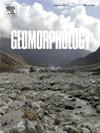Sea level during Marine Isotope Stage 5a in the Messiniakos Gulf (Peloponnese Peninsula, Greece)
IF 3.1
2区 地球科学
Q2 GEOGRAPHY, PHYSICAL
引用次数: 0
Abstract
Reconstructing past sea levels is essential for understanding the long-term interactions between climate change, ice sheet stability, tectonic activity, and coastal impacts. Here, we present new constraints on the Marine Isotope Stage (MIS) 5a sea-level highstand from the tectonically active Messiniakos region of southwestern Peloponnese Peninsula (Greece), in the eastern Mediterranean. Using 4 ± 2 m above present sea level (mapsl) as a reference eustatic value for MIS 5e, we estimate the sea-level position for MIS 5a by integrating multiple lines of evidence. These include a U-series dated hiatus (~81.0 to ~71.0 ka) in a stalagmite at 18 mapsl, a marine terrace, and a presumed MIS 5a Lithophaga-bored notch found at 16.5 mapsl, with a shell U-series age of 85 ± 8 ka. The hiatus in the stalagmite is further supported by a rise in 87Sr/86Sr values within the hiatus zone, likely influenced by seawater aerosol input during sea-level highstand. Accounting for regional tectonic uplift, which places the MIS 5e shoreline at 32 mapsl, our findings suggest that the MIS 5a paleo-sea level was −0.7 ± 3.2 m below present sea level. Although this estimate does not include corrections for glacial isostatic adjustment, it provides a valuable baseline for understanding past sea-level highstands in the eastern Mediterranean, where regional reconstructions remain limited despite numerous studies of marine terraces.

希腊伯罗奔尼撒半岛Messiniakos湾海洋同位素阶段5a期间的海平面
重建过去的海平面对于理解气候变化、冰盖稳定性、构造活动和沿海影响之间的长期相互作用至关重要。本文提出了东地中海伯罗奔尼撒半岛西南部(希腊)Messiniakos地区构造活跃的海洋同位素阶段(MIS) 5a海平面高点的新约束条件。利用当前海平面以上4±2 m (mapsl)作为MIS 5e的参考起伏值,我们通过综合多条证据线来估计MIS 5a的海平面位置。其中包括在18 mapsl的石笋中发现的u系列断裂带(~81.0 ~ ~71.0 ka),一个海相阶地,以及在16.5 mapsl发现的推测为MIS 5a的lithophaga -钻孔缺口,壳u系列年龄为85±8 ka。中断区内87Sr/86Sr值的升高进一步支持了石笋中的中断,这可能受到海平面高水位期间海水气溶胶输入的影响。考虑到区域构造隆升将MIS 5e岸线置于32 mapsl,我们的研究结果表明MIS 5a古海平面比现在海平面低- 0.7±3.2 m。虽然这一估计不包括对冰川均衡调整的修正,但它为了解地中海东部过去的海平面高点提供了有价值的基线,尽管对海洋阶地进行了大量研究,但该地区的区域重建仍然有限。
本文章由计算机程序翻译,如有差异,请以英文原文为准。
求助全文
约1分钟内获得全文
求助全文
来源期刊

Geomorphology
地学-地球科学综合
CiteScore
8.00
自引率
10.30%
发文量
309
审稿时长
3.4 months
期刊介绍:
Our journal''s scope includes geomorphic themes of: tectonics and regional structure; glacial processes and landforms; fluvial sequences, Quaternary environmental change and dating; fluvial processes and landforms; mass movement, slopes and periglacial processes; hillslopes and soil erosion; weathering, karst and soils; aeolian processes and landforms, coastal dunes and arid environments; coastal and marine processes, estuaries and lakes; modelling, theoretical and quantitative geomorphology; DEM, GIS and remote sensing methods and applications; hazards, applied and planetary geomorphology; and volcanics.
 求助内容:
求助内容: 应助结果提醒方式:
应助结果提醒方式:


